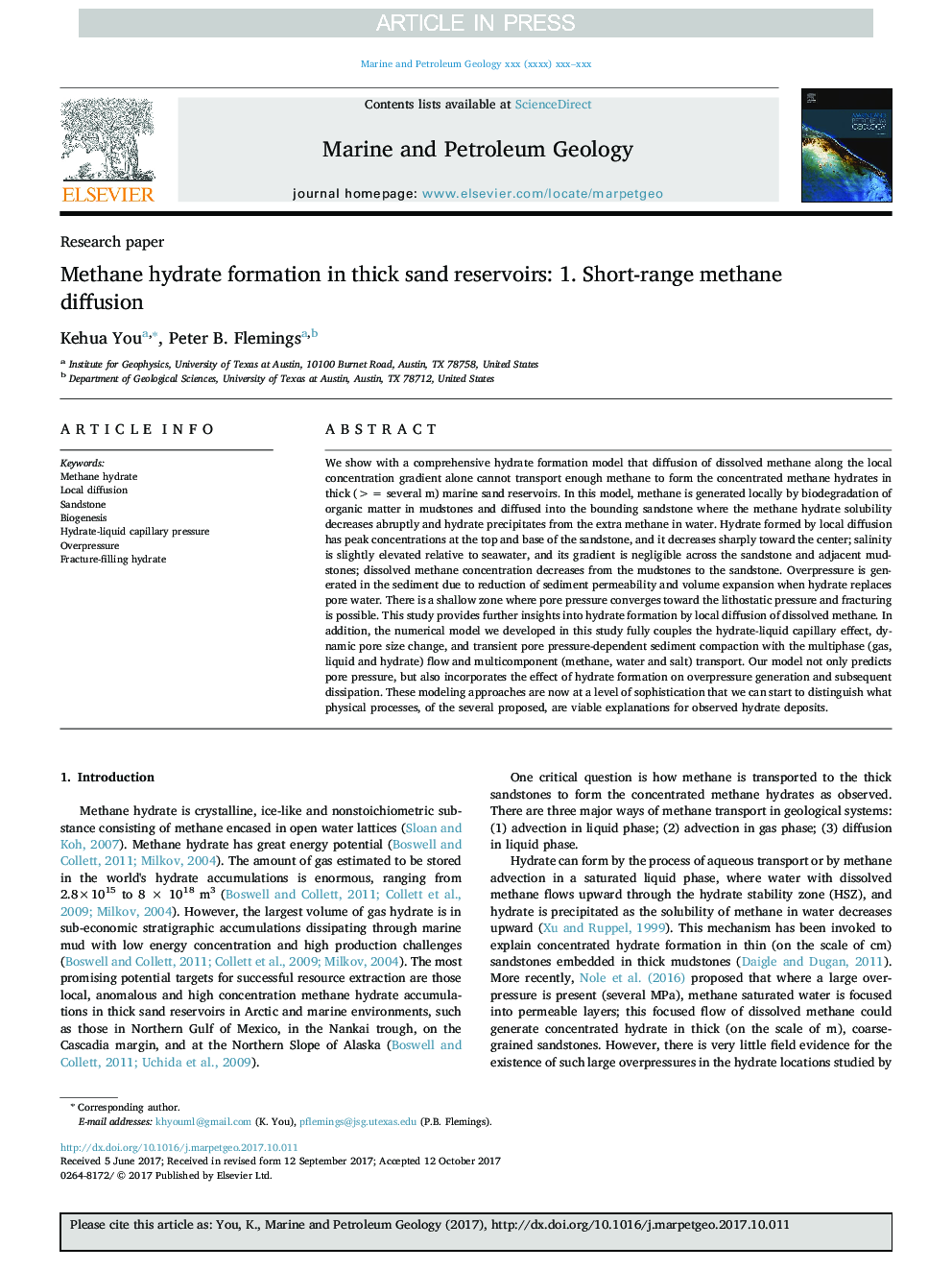| کد مقاله | کد نشریه | سال انتشار | مقاله انگلیسی | نسخه تمام متن |
|---|---|---|---|---|
| 8909288 | 1637137 | 2018 | 15 صفحه PDF | دانلود رایگان |
عنوان انگلیسی مقاله ISI
Methane hydrate formation in thick sand reservoirs: 1. Short-range methane diffusion
ترجمه فارسی عنوان
تشکیل هیدرات متان در مخازن ماسه ای ضخیم: 1. انتشار متان کمینه
دانلود مقاله + سفارش ترجمه
دانلود مقاله ISI انگلیسی
رایگان برای ایرانیان
کلمات کلیدی
هیدرات متان، انتشار محلی، ماسه سنگ، بیوگرافی، فشار مایع هیدرات-مایع بیش از حد، شکست هورمون پر شدن،
ترجمه چکیده
ما با یک مدل جامد هیدرات شکل نشان می دهیم که انتشار متان حل شده در امتداد گرادیان غلظت محلی به تنهایی نمی تواند به اندازه کافی متان به اندازه کافی متان هیدرات متان را در مخازن ماسه ای دریایی ضخیم (> = چند متر) حمل کند. در این مدل، متان به صورت محلی توسط تجزیه بیولوژیکی مواد آلی در معادن سنگ معدن تولید می شود و به ماسه سنگ محدود می شود که محلول هیدرات متان را به طور ناگهانی کاهش می دهد و رسوبات هیدرات از متان اضافی در آب. هیدرات تشکیل شده توسط انتشار محلی، دارای پیک غلظت در بالا و پایه ماسه سنگ است و به شدت به سمت مرکز کاهش می یابد؛ شوری کمی نسبت به آب دریا افزایش یافته است و گرادیان آن در سراسر ماسه سنگ و گران سنگ های مجاور ناچیز است؛ غلظت متان متشکل از سنگ معدن به ماسه سنگ کاهش می یابد. غلظت فشار در رسوبات به علت کاهش نفوذپذیری رسوب و افزایش حجم زمانی که هیدرات جایگزین آب معدنی می شود تولید می شود. یک ناحیه کم عمق وجود دارد که فشار منبسط به سمت فشار لیتستاتیک میسوزد و شکستن ممکن است. این مطالعه بینش های بیشتری را در مورد تشکیل هیدرات توسط انتشار محلی متان محلول ارائه می دهد. علاوه بر این، مدل عددی که در این تحقیق توسعه داده شد به طور کامل اثر موئینی هیدرات-مایع، تغییر اندازه اندازه ذره و تراکم رسوب وابسته به فشار منافذ موقت را با جریان چند مرحلهای (گاز، مایع و هیدرات) و چند قطعه (متان، آب و نمک) حمل و نقل. مدل ما نه تنها فشار منبر را پیش بینی می کند، بلکه تأثیر تشکیل هیدرات را بر روی تولید بیش از حد فشار و انحلال پس از آن نیز می گیرد. این روشهای مدل سازی اکنون در سطح پیچیده هستند که ما می توانیم شروع کنیم تا مشخص کنیم فرایندهای فیزیکی چندین پیشنهاد، توضیحات پایدار برای رسوب های هیدرات قابل مشاهده است.
موضوعات مرتبط
مهندسی و علوم پایه
علوم زمین و سیارات
زمین شناسی اقتصادی
چکیده انگلیسی
We show with a comprehensive hydrate formation model that diffusion of dissolved methane along the local concentration gradient alone cannot transport enough methane to form the concentrated methane hydrates in thick (>= several m) marine sand reservoirs. In this model, methane is generated locally by biodegradation of organic matter in mudstones and diffused into the bounding sandstone where the methane hydrate solubility decreases abruptly and hydrate precipitates from the extra methane in water. Hydrate formed by local diffusion has peak concentrations at the top and base of the sandstone, and it decreases sharply toward the center; salinity is slightly elevated relative to seawater, and its gradient is negligible across the sandstone and adjacent mudstones; dissolved methane concentration decreases from the mudstones to the sandstone. Overpressure is generated in the sediment due to reduction of sediment permeability and volume expansion when hydrate replaces pore water. There is a shallow zone where pore pressure converges toward the lithostatic pressure and fracturing is possible. This study provides further insights into hydrate formation by local diffusion of dissolved methane. In addition, the numerical model we developed in this study fully couples the hydrate-liquid capillary effect, dynamic pore size change, and transient pore pressure-dependent sediment compaction with the multiphase (gas, liquid and hydrate) flow and multicomponent (methane, water and salt) transport. Our model not only predicts pore pressure, but also incorporates the effect of hydrate formation on overpressure generation and subsequent dissipation. These modeling approaches are now at a level of sophistication that we can start to distinguish what physical processes, of the several proposed, are viable explanations for observed hydrate deposits.
ناشر
Database: Elsevier - ScienceDirect (ساینس دایرکت)
Journal: Marine and Petroleum Geology - Volume 89, Part 2, January 2018, Pages 428-442
Journal: Marine and Petroleum Geology - Volume 89, Part 2, January 2018, Pages 428-442
نویسندگان
Kehua You, Peter B. Flemings,
